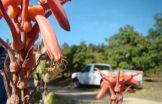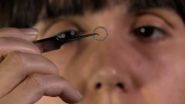(Press-News.org) ROCHESTER, Minn. — Most patients whose breast cancer has spread to their lymph nodes have most of the lymph nodes in their armpit area removed after chemotherapy to see if any cancer remains. A study conducted through the American College of Surgeons Oncology Group and led by Judy Boughey, M.D. a breast surgeon at Mayo Clinic shows that a less invasive procedure known as sentinel lymph node surgery successfully identified whether cancer remained in lymph nodes in 91 percent of patients with node-positive breast cancer who received chemotherapy before their surgery. In sentinel lymph node surgery, only a few lymph nodes, the ones most likely to contain cancer, are removed. The findings are being presented at the 2012 CTRC-AACR San Antonio Breast Cancer Symposium.
"Since treatment with chemotherapy before surgery can eliminate cancer in the lymph nodes in some patients, we were interested in evaluating whether sentinel lymph node surgery could successfully identify whether cancer remained in the lymph nodes after chemotherapy," says Dr. Boughey. Removing only a few lymph nodes reduces the risk of surgical complications such as numbness and arm swelling, she says.
Researchers studied 756 women with node-positive breast cancer who received chemotherapy as an initial treatment. Of study participants, 637 patients had both sentinel lymph node and axillary lymph node surgery. Sentinel lymph node surgery correctly identified whether cancer lingered in 91 percent of patients, including 255 patients with node-negative breast cancer and 326 patients with continuing node-positive disease.
Researchers also found that 40 percent of the patients had complete eradication of the cancer from the lymph nodes. The study had a false-negative rate of 12.6 percent and the false negative rate was significantly lower with the use of dual tracers (blue dye and radiolabeled colloid) to identify the sentinel lymph nodes.
Dr. Boughey says that technical factors in surgery are important to help ensure correct staging, the process of determining how far cancer may have spread.
###
The study was conducted through the American College of Surgeons Oncology Group and funded by the National Cancer Institute.
Other authors include: Vera Suman, Ph.D., Mayo Clinic, Rochester; Elizabeth Mittendorf, M.D., MD Anderson Cancer Center; Gretchen Ahrendt, M.D., Magee-Women's Surgical Associates; Lee Wilke, M.D., University of Wisconsin, Madison; Bret Taback, M.D., Columbia University Medical Center; M. Leitch, M.D., University of Texas Southwestern Medical Center, Dallas; Teresa Flippo-Morton, M.D., Carolina's Medical Center, Charlotte; David Byrd, M.D., University of Washington Medical Center, Seattle; David Ollila, M.D., University of North Carolina- Chapel Hill; Thomas Julian, M.D., Allegheny General Hospital, Pittsburgh; Sarah McLaughlin, M.D., Mayo Clinic, Jacksonville; Linda McCall, Duke University Medical Center; W. Symmans, M.D., MD Anderson Cancer Center; Huong Le-Petross, M.D., MD Anderson Cancer Center; Bruce Haffty, M.D., The Cancer Institute of New Jersey; Thomas Buchholz, M.D., MD Anderson Cancer Center, Kelly Hunt, M.D., M.D. Anderson Cancer Center.
MULTIMEDIA ALERT: Animation and a video interview with Dr. Boughey are available for journalists to download on the Mayo Clinic News Network.
About Mayo Clinic Cancer Center
As a leading institution funded by the National Cancer Institute, Mayo Clinic Cancer Center conducts basic, clinical and population science research, translating discoveries into improved methods for prevention, diagnosis, prognosis and therapy. For information on cancer clinical trials, call 507-538-7623.
About Mayo Clinic
Mayo Clinic is a nonprofit worldwide leader in medical care, research and education for people from all walks of life. For more information, visit MayoClinic.com or MayoClinic.org/news.
Journalists can become a member of the Mayo Clinic News Network for the latest health, science and research news and access to video, audio, text and graphic elements that can be downloaded or embedded.
"We find that 87% of the 15 largest (8.6 magnitude or higher) and half of the 50 largest (8.4 magnitude or higher) earthquakes of the past century are associated with intersection regions between oceanic fracture zones and subduction zones," says Dietmar Müller, researcher at the University of Sydney in Australia and lead author of the Solid Earth paper. The connection is less striking for smaller earthquakes.
Powerful earthquakes related to these intersection regions include the destructive 2011 Tohoku-Oki and 2004 Sumatra events.
"If the association we found were ...
NARRAGANSETT, R.I. – December 5, 2012 – Scientists have long used the speed of seismic waves traveling through the Earth as a means of learning about the geologic structure beneath the Earth's surface, but the seismic waves they use have typically been generated by earthquakes or man-made explosions. A University of Rhode Island graduate student is using the tiny seismic waves created by ocean waves crashing on shorelines around the world to learn how an underwater plateau was formed 122 million years ago.
"There are any number of ways to create seismic waves, but most ...
NARRAGANSETT, R.I. – December 5, 2012 – Oceanographers at the University of Rhode Island have analyzed long-term data from several anemometers in southern New England and found that average wind speeds have declined by about 15 percent at inland sites while speeds have remained steady at an offshore site.
Kelly Knorr, a graduate student at the URI Graduate School of Oceanography, and Professor John Merrill reported the results of their research today at the fall meeting of the American Geophysical Union in San Francisco.
The researchers found that average wind speeds ...
SAN FRANCISCO, CA—December 5, 2012—Despite researchers' best efforts, no drug exists that can slow, halt or reverse the onslaught of Alzheimer's disease. A progressive and fatal neurodegenerative disorder, Alzheimer's has stolen the memories and livelihoods of millions—leaving patients and their families struggling to cope with the disease's devastating consequences. But today, scientists at the Gladstone Institutes propose a new research avenue that has the potential to change all that.
In the latest issue of the journal Neuron, available today online, Gladstone Investigators ...
The search for the origin of modern human behaviour and technological advancement among our ancestors in southern Africa some 70 000 years ago, has taken a step closer to firmly establishing Africa, and especially South Africa, as the primary centre for the early development of human behaviour.
A new research paper by renowned Wits University archaeologist, Prof. Christopher Henshilwood, is the first detailed summary of the time periods he and a group of international researchers have been studying in South Africa: namely the Still Bay techno-traditions (c. 75 000 – 70 ...
Scientists have discovered 100 million-year-old regions in the DNA of several plant species which could hold secrets about how specific genes are turned 'on' or 'off'.
The findings, which are hoped will accelerate the pace of research into crop science and food security, are detailed by University of Warwick researchers in the journal The Plant Cell.
By running a computational analysis of the genomes of the papaya, poplar, Arabidopsis and grape species, scientists have uncovered hundreds of conserved non-coding sequences which are found in the DNA of all four species.
These ...
A combined team of scientists from Europe and South Africa (Luísa G. Carvalheiro (University of Leeds, UK & Naturalis Biodiversity Research Centre, Netherlands), Colleen Seymour and Ruan Veldtman (SANBI, South Africa) and Sue Nicolson (University of Pretoria)) have discovered that pollinator services of large agriculture fields can be enhanced with a simple cost-effective measure, that involves the creation of small patches of native plants within fruit orchards.
"Mango farmers in South Africa are aware of the pollination limitation of this crop and invest a substantial ...
In research published in the journal Acta Biomaterialia, researchers from the University of Sheffield describe a new method for producing membranes to help in the grafting of stem cells onto the eye, mimicking structural features of the eye itself. The technology has been designed to treat damage to the cornea, the transparent layer on the front of the eye, which is one of the major causes of blindness in the world.
Using a combination of techniques known as microstereolithography and electrospinning, the researchers are able to make a disc of biodegradable material which ...
Experts already know that pregnant women should not eat for two. A study now insists on the importance of a healthy diet as a way of avoiding increased insulin and glucose levels in the child, both of which are indicators of diabetes and metabolic syndrome risk.
Maternal diet quality during pregnancy is fundamental to foetal growth as well as insulin and glucose levels at birth. Such indications warn of the possible predisposition to suffer from illnesses like diabetes and metabolic syndrome.
The study was headed by the Complutense University of Madrid and published ...
Scientists have demonstrated a new way to investigate mechanisms at work in Alzheimer's and other neurodegenerative diseases, which also could prove useful in the search for effective drugs. For new insights, they turned to the zebrafish, which is transparent in the early stages of its life. The researchers developed a transgenic variety, the "MitoFish," that enables them to see – within individual neurons of living animals – how brain diseases disturb the transport of mitochondria, the power plants of the cell.
Neurodegenerative diseases such as Alzheimer's, Parkinson's, ...




